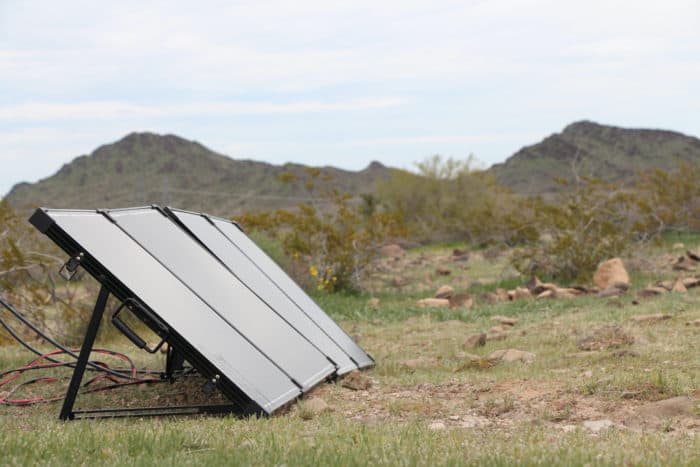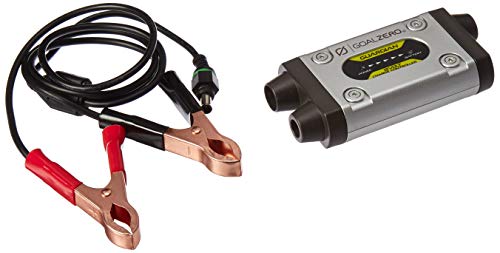Using Goal Zero Solar Panels With 12 Volt Deep Cycle Batteries Found In RVs
Goal Zero makes solar panels in a lot of different sizes. Their more portable panels are for the hikers and backpackers, while their Nomad and Boulder panels are larger and better suited for RV, car, or van travelers.
These portable solar panels are often paired with the Goal Zero Yeti power stations, which basically are 12V batteries with a solar charge controller and an inverter, making them great off-grid solutions for campers. They’re also used by homeowners used to power outages for emergency uses. But how do you charge a 12V battery with Goal Zero panels?
Related Post: 10 Things You Should Know Before Buying A Goal Zero Yeti
While the Yeti power stations/solar generators are powerful machines capable of powering a lot of things, even my travel trailer, it’s always good to have an additional backup. Regular 12V deep cycle lead-acid batteries are the more common battery found on RV campers, and since we love solar panels around here, wouldn’t it be great to be able to use the Goal Zero panels to charge a battery not made by Goal Zero?
How To Connect A Goal Zero Solar Panel To A 12 Volt RV Deep Cycle Lead-Acid Battery
The problem with the Goal Zero solar panels is that they don’t have MC4 connectors or alligator clips, they’re either USB, 8mm, or APP (Anderson Power Pole).
Not only that, but the 8mm and APP panels don’t have a built-in solar charge controller, which you’re going to want between the solar panel and your battery to prevent overcharging.
Related Post: Goal Zero Nomad 100 Vs Boulder 100
Goal Zero has released the solution for this, and it’s called the Guardian 12V Plus Charge Controller.
Guardian 12V Plus Charge Controller
The Guardian 12V charge controller has an 8mm input so you can connect Goal Zero solar panels to it. You’ll then use the alligator clips coming out of the output port on the Guardian to connect it to your battery. Remember to connect the positive (red) clip first to the positive terminal on the battery, then the negative (black) clip to the negative terminal.
When removing the clips you start with the negative (black) clip, then the positive (red) clip.
Connect the Guardian charge controller to your battery before you connect the solar panel to the charge controller.
What 12V Batteries Does It Support? Lithium?
The Guardian Plus charge controller only works with lead-acid deep-cycle batteries. It does not work with lithium batteries. Lead-acid and lithium batteries do not share the same voltage preferences, so connecting the Guardian charger to a lithium battery is not recommended.
What If The Goal Zero Solar Panel Has An APP (Anderson Power Pole) Output?
Goal Zero large panels come with an APP output cable instead of an 8mm, then you’re going to need a Goal Zero APP to 8mm adapter.
Note that the Guardian Plus charge controller maxes out at 90 watts.
How Long Will It Take To Charge My RV Battery With A Goal Zero Panel?
It depends on several factors, how big your battery is, and how big the solar panel is are two of them. Then you need the sun to shine.
Generally speaking, a 100W solar panel can generate about 5-6 amps an hour. RV camper batteries are usually around 30-50 amp hours, so in the perfect world, it would take less than 9 hours to charge it from empty to full.
You should never let a lead-acid battery drain completely though, as it damages the battery and reduces its overall battery capacity in the long run. Lead-acid batteries should be kept above 50%.
Related Post: 5 Ways To Charge A Goal Zero Yeti Faster
If your RV/travel trailer batteries are at 50% and you have 100Ah battery capacity, you can expect the battery to be fully charged after about 9 hours in good sunshine.
Can I Combine Two Or More Goal Zero Panels To Charge a 12V Battery?
Yes, you can combine several panels if they have the 8mm output with the use of a Goal Zero 8mm to Anderson x4 combiner. You would then need a Goal Zero APP to 8mm adapter to be able to plug the panels into the Guardian Plus charge controller.
Should I Connect The Solar Panels To The Charge Controller Before Connecting The Battery?
No, you should always start by connecting the charge controller to the 12V battery before connecting the solar panels. Connect the positive (red) clip first to the positive terminal on the battery, then the negative (black) clip to the negative terminal.
When it’s done charging, disconnect the solar panel from the charge controller, then remove the clips, starting with the negative (black) clip, then the positive (red) clip.
What Are The Best Alternatives To Charge A 12V Lead-Acid Battery With Solar Panels?
The best alternative is to get a portable panel with a solar charge controller. I own two Renogy 100W briefcase panels which is a plug-and-play system with a prewired solar charge controller, and alligator clips that you connect to your 12V battery. These panels with the charge controller pre-installed are compatible with not only lead-acid but with 12V lithium batteries as well.

Related Post: Renogy Lithium Vs Battle Born Batteries
The Renogy briefcase would recharge the batteries in the same amount of time unless you go with the larger Renogy 200W briefcase panels which would double the charging speed.
Renogy’s 200W configuration is quite heavy though at almost 40 pounds. But if you go camping for a week at every place, you can set them up when you get there, leave them out, and take them down when it’s time to go, so the 40 pounds might not be too much of a burden to you.
A great feature with the Renogy panels mentioned above is the charge controller that lets you monitor your battery and solar charging.
If you have any questions, feel free to leave a comment down below.



Hi Jesse,
Great info.
I have the Boulder 100 briefcase panels but have found out that Goal Zero is no longer making the guardian charge controller – after searching high and low on the internet I have not been able to find any – new or used. Is there any other brand charge controller that could be fitted to the Boulder 100 or is the only feasible way to use these panels to charge my trailer battery would be to charge my Yeti 400 and then plug the trailer into the Yeti?
Hello Warren,
Thanks for letting me know that they’ve discontinued the Guardian charge controller.
It seems like there is no quick and easy way anymore. What you can do is get a Goal Zero 8mm extension cable, cut off the male part and install MC4 connectors so it will be an 8mm female to MC4 connector cable, then connect the MC4 connectors to a solar charge controller like the Acopower ProteusX 20A, and then connect the charge controller to your 12V batteries.
At that point and price, you might as well just buy an HQST 100 Watt portable solar panel suitcase, or plug your trailer into the Yeti if it can handle the wattage the converter charger needs.
Let me know if you have any questions or find a better solution.
Jesse
If I have a lithium battery (no goal zero) can I charge them with de boulder 100?
Hey Victor,
Sure, it’s definitely possible, but it takes some parts and work. I haven’t tested this myself but I have heard of others doing it.
Here is what I would buy:
Renogy Wanderer 30A – Charge controller that supports lithium batteries.
SolarEnz 8mm Female to SAE Connector – This is what you’ll plug the Goal Zero Boulder 100 into.
LIXIN 14AWG SAE Connector – This will connect to the charge controller and the 8mm adapter above to make the connection between the Boulder 100 panel and the charge controller. It will also connect the controller to the battery, so you need two of them.
Then you need a way to connect the SAE connector coming out of the controller to your battery. You can either use SAE to battery clamps, or SAE to ring terminals.
Before connecting it all, just make sure the polarity is correct, meaning that the positive wire ends up going to the positive terminal on the battery, and negative to negative.
Let me know if you have any questions.
Jesse
Hey there Jesse, seems Goal Zero now sells a charge controller: https://www.goalzero.com/shop/accessories/10a-charge-controller. Is there such thing as a spade to battery ring terminal connector? Looking for a cheaper alternative. Thanks!
Hi Laura,
Thanks for sharing, I didn’t know they released new models.
Do you mean a cheaper charge controller or just a cheaper cable to connect to your battery? Which solar panel do you have?